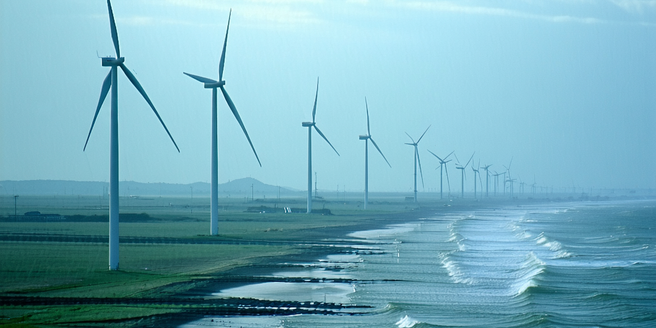
Understanding the Potential of Monsoon Winds
Monsoon winds present a powerful source of renewable energy that remains largely untapped. These seasonal winds, characterized by their predictability and strength, can provide a steady stream of energy during the rainy months. As monsoons result from atmospheric pressure changes over the ocean and land, they create significant wind patterns that can be harvested efficiently. By understanding when and where these winds are strongest, energy strategists can optimize the placement of wind turbines to harness this natural phenomenon. The potential energy output during these periods can contribute significantly to a region’s energy needs, reducing reliance on fossil fuels and increasing energy sustainability. A comprehensive study of local monsoon wind patterns is crucial for designing effective wind energy systems, ensuring energy security even amidst climatic challenges.
The Science Behind Wind Energy in Stormy Weather
Harnessing wind energy during stormy weather involves understanding the meteorological science of monsoon systems. Monsoon winds are relentlessly powerful due to the significant temperature and pressure differences between land and sea. These winds accelerate as they meet regional topographies, offering an opportunity for energy capture. Wind turbines designed for these conditions must be robust enough to withstand heavy rains and strong gusts, featuring aerodynamic blades and storm-resilient structures. The kinetic energy in these high-speed wind currents is converted into mechanical power, driving turbines at optimal efficiency. Innovative forecasting techniques, including satellite data and on-ground sensors, enable precise predictions of wind speeds and directions, optimizing turbine performance. Understanding the mechanics of monsoon winds aids engineers in designing turbines that safely and effectively convert stormy weather into renewable energy.
Challenges of Capturing Wind Energy in Monsoons
Capturing wind energy during monsoon seasons presents numerous challenges, primarily due to the harsh and unpredictable weather conditions. The intense rains, high humidity, and violent storm winds necessitate specially designed equipment capable of withstanding extreme forces without compromising energy efficiency. The siting of wind turbines becomes crucial, as areas prone to landslides or flooding can disrupt operations and reduce safety. Additionally, turbines must be fortified against lightning strikes common during these storms, incorporating advanced grounding systems. Another significant challenge is maintaining operational efficiency while ensuring minimal environmental disruption to local ecosystems. Balancing these challenges requires innovation and careful planning, emphasizing the importance of durable materials and cutting-edge engineering solutions to maximize energy capture without adverse effects.
Technological Innovations for Monsoon Wind Harnessing
Innovating technologies are paving new pathways to harness wind energy effectively during monsoon seasons. Modern wind turbines are now being equipped with resilient materials that endure severe weather, including lightweight composites and advanced corrosion-resistant coatings that ensure longevity and performance. The development of smart sensors provides real-time monitoring of wind patterns and turbine conditions, allowing for dynamic adjustments to blade positioning and rotational speed. Additionally, aerodynamic enhancements in turbine design minimize drag and maximize energy conversion, optimizing output even in gusty conditions. Hybrid systems that integrate wind and solar power hold promise for stable energy supply during periods of intermittence. These innovations collectively advance the potential for sustainable energy generation in monsoon climates, showcasing a commitment to technological excellence and environmental stewardship.
Case Studies: Successful Wind Projects in Monsoon Areas
There are exemplary wind energy projects in monsoon-prone regions globally that highlight effective harnessing strategies. India’s Muppandal Wind Farm is situated in Tamil Nadu, benefiting from the high-speed monsoon winds that sweep across the open plains, making it the largest wind farm in South Asia. This site exemplifies efficient turbine placement and adaptation to local climatic conditions. Meanwhile, offshore projects in the Philippines have achieved success by capitalizing on coastal monsoon winds, with specialized marine turbines designed to withstand saline environments. By optimizing turbine blade design and using predictive maintenance practices, these projects achieve sustained energy output. Each case study exemplifies crucial lessons in adapting to and leveraging monsoon conditions, with significant contributions to energy grids and local economies.
Future Prospects for Wind Energy in Monsoon Climates
The future of wind energy in monsoon climates is promising, driven by technological advancements and increasing investments in renewable resources. Continued research into meteorological patterns will enhance wind forecasting, optimizing energy capture and reducing downtime even further. Emerging turbine designs are expected to focus on flexibility and adaptability, ensuring resilience against climate change-induced variations. There is potential for expanded cross-border collaborations to develop shared infrastructure, improving regional energy networks’ efficiency during monsoon seasons. As countries commit to reducing carbon footprints, policies will increasingly support monsoon wind investments, driving innovation. The integration of AI in managing and monitoring turbine performance stands to revolutionize the sector. These prospects underscore the global transition towards sustainable energy, with monsoon winds playing a pivotal role in the renewable energy landscape.
